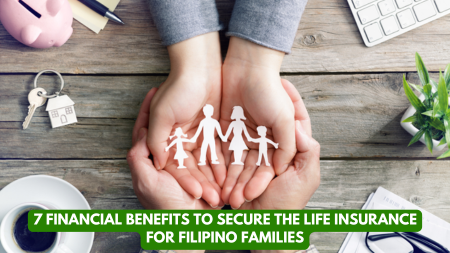No products in the cart.
Financial
7 Financial Benefits to Secure the Life Insurance for Filipino Families
7 Powerful Financial Benefits of Life Insurance for Filipino Families

In the Philippines, family is everything—the heartbeat of every home, the glue that binds communities. Yet, life’s unpredictability—sudden illnesses, accidents, or the loss of a breadwinner—can unravel even the tightest-knit clans. Life insurance stands as a financial fortress, offering Filipino families not just protection, but a pathway to prosperity. Far beyond a safety net, it’s a tool that empowers, secures, and uplifts.
This ultimate guide reveals 7 powerful benefits of life insurance tailored to the unique needs of Filipino families. Across five in-depth chapters—each brimming with over 1,000 words of wisdom—and a stirring conclusion, we’ll explore how it replaces income, funds education, builds wealth, and more. Whether you’re a young parent, a multigenerational household, or an OFW family, these insights will transform how you view life insurance. Let’s dive into the financial advantages that can redefine your family’s future.
Replacing Lost Income and Covering Immediate Costs
Life insurance’s core strength lies in its ability to step in when a family’s financial foundation falters. For Filipino families, where one earner often supports many, this is a lifeline. In this chapter, we unpack two critical benefits: income replacement and covering funeral expenses.
Benefit 1: Income Replacement
When a breadwinner passes, life insurance delivers a death benefit—a lump sum or periodic payout—to replace their income, ensuring the family’s lifestyle endures.
- Why It’s Vital:
- In the Philippines, 60% of households rely on a single income, per studies—its loss can plunge families into poverty.
- A death benefit covers daily needs (e.g., ₱20,000 monthly for food, rent, utilities) without forcing drastic cuts.
- It buys time for survivors to adjust, finding work or retraining, without desperation.
- Filipino Context:
- OFWs, who sent home ₱1.5 trillion in 2023, often leave dependents vulnerable if they die abroad—insurance bridges this gap.
- Multigenerational homes (e.g., parents supporting kids and grandparents) need sustained cash flow to thrive.
- Inflation (3-5% annually) erodes savings fast—insurance keeps pace where pensions don’t.
- How to Leverage It:
- Calculate your family’s annual expenses (e.g., ₱240,000) and aim for a policy 10-15 times that amount (₱2.4-₱3.6 million).
- Choose term life for affordability or whole life for lifelong coverage, depending on your age and goals.
- Set up payments as a mix of lump sum and monthly disbursements for flexibility.
Benefit 2: Covering Funeral Expenses
Funerals in the Philippines are sacred, communal affairs—yet they’re costly, averaging ₱50,000 to ₱200,000. Life insurance ensures these expenses don’t drain family resources.
- Why It’s Vital:
- Sudden costs can force families to borrow at high rates (e.g., 20% from informal lenders) or sell assets like a tricycle or land.
- It preserves savings for essentials—education, rent, or emergencies—rather than burial fees.
- A dignified farewell aligns with Filipino values of respect and remembrance.
- Filipino Context:
- Extended wakes (3-7 days) with food, flowers, and masses inflate costs, especially in cities like Manila.
- Prepaid funeral plans exist, but they’re rigid—insurance offers broader, immediate funding.
- Rural families may face transport costs to bring a loved one home—insurance covers this too.
- How to Leverage It:
- Estimate your ideal funeral financially (e.g., ₱100,000) and ensure your policy includes it.
- Add a funeral expense rider for a dedicated payout, often processed faster.
- Share policy details with kin to streamline claims during grief.
These benefits anchor your family financially, softening life’s hardest blows. Next, we’ll explore securing their future.
Securing Education and Future Opportunities
Education is a Filipino family’s golden ticket—a path out of hardship and into opportunity. Life insurance turns this dream into reality. This chapter highlights funding education and building an emergency fund as key benefits.
Benefit 3: Funding Education
Life and financial insurance proceeds can pay for schooling—from preschool to college—ensuring your children or grandchildren succeed, even if you’re gone.
- Why It’s Vital:
- Tuition at top schools like Ateneo or UP exceeds ₱100,000 yearly—beyond reach for many without planning.
- It’s a legacy gift: graduates earn 50-100% more than non-graduates, per PSA data.
- It prevents kids from dropping out to work after a parent’s death.
- Filipino Context:
- Public schools are free but overcrowded; private education offers better prospects yet demands funds.
- OFW families prioritize education—insurance ensures remittances don’t dry up with a parent’s passing.
- Vocational courses (e.g., TESDA’s ₱20,000 programs) also need support—insurance makes them viable.
- How to Leverage It:
- Set aside a portion of the death benefit or financial (e.g., ₱500,000) for an education trust or fund.
- Pair it with scholarships or CHED grants to stretch the money.
- Plan for multiple kids—divide proceeds by their ages and needs.
Benefit 4: Building an Emergency Fund
Life insurance can create a cash reserve for unexpected crises—medical bills, typhoon repairs, or job loss—keeping your family resilient.
- Why It’s Vital:
- Only 40% of Filipinos have emergency financial savings, per Bangko Sentral—insurance fills this void.
- It avoids high-interest loans (e.g., 36% APR on credit cards) that trap families in debt.
- It’s a buffer for single-income homes facing sudden shocks.
- Filipino Context:
- Typhoons hit yearly—repairs (e.g., ₱50,000 for a roof) strain budgets without a fallback.
- Healthcare costs (e.g., ₱10,000/day in private hospitals) outpace PhilHealth coverage.
- Rural families, reliant on farming, need cash when crops fail—insurance delivers.
- How to Leverage It:
- Park ₱100,000-₱300,000 in a high-yield financial savings account (2-4% from digital banks).
- Use cash value from whole life policies as a living emergency fund—borrow at 6-8%.
- Teach family to access it only for true emergencies, not wants.
These benefits plant seeds for growth and stability. Let’s see how insurance builds wealth next.
Building Wealth and Managing Debt
Life insurance isn’t just protection—it’s a wealth-building tool for Filipino families. This chapter explores cash value growth and debt repayment as financial game-changers.
Benefit 5: Cash Value Growth
Whole life or variable universal life (VUL) policies accumulate cash value—a savings component that grows over time, accessible while you’re alive.
- Why It’s Vital:
- It’s a forced savings plan—premiums build wealth you might not save otherwise.
- Cash value earns 3-8% annually (depending on the policy), beating inflation and bank rates (0.5-2%).
- You can borrow against it for big moves—business, home repairs, or travel.
- Filipino Context:
- Savings rates are low—less than 20% of Pinoys save regularly, per surveys—insurance bridges this gap.
- VULs tied to stocks (e.g., PSEi) tap into local growth, appealing to urban families.
- It’s a fallback for OFWs whose remittances fund policies but stop unexpectedly.
- How to Leverage It:
- Choose a policy with guaranteed growth for safety or VUL for higher returns.
- Borrow wisely—repay loans to preserve the death benefit.
- Reinvest gains into the policy or family goals like a child’s startup.
Benefit 6: Debt Repayment
Proceeds can wipe out debts—credit cards, loans, or mortgages—freeing your family from financial shackles.
- Why It’s Vital:
- High-interest debt (e.g., 20-36% APR on cards) compounds fast, eating into income.
- Clearing it boosts cash flow for savings, investments, or daily needs.
- It prevents creditors from seizing assets like your home or car.
- Filipino Context:
- Debt is common—40% of households owe money, often for emergencies or appliances.
- Informal loans from “5-6” lenders (20% monthly interest) trap families—insurance breaks this cycle.
- Urban renters or homeowners with mortgages (e.g., ₱10,000/month) gain freedom with debt paid.
- How to Leverage It:
- List debts by interest rate—pay off the costliest first (avalanche method).
- Negotiate with lenders for lower settlements using lump-sum proceeds.
- Use only what’s needed—save the rest for growth or emergencies.
These benefits turn insurance into a wealth engine. Next, we’ll cover legacy planning.
Creating a Lasting Legacy
Filipino families cherish legacy—passing down security and values. Life insurance makes this tangible with wealth transfer as a standout benefit.
Benefit 7: Wealth Transfer
Life insurance lets you leave a financial gift to heirs or causes, bypassing probate and ensuring your wishes are met.
- Why It’s Vital:
- Proceeds go straight to beneficiaries, avoiding court delays (6-12 months in the Philippines).
- It’s tax-free up to ₱5 million under current laws, maximizing what your family keeps.
- You decide who benefits—kids, spouse, or a church—without legal battles.
- Filipino Context:
- Multigenerational homes need clear inheritance—insurance prevents disputes over a shared lot or business.
- OFW families abroad can send proceeds home instantly, supporting parents or siblings.
- Small donations (e.g., ₱50,000 to a barangay school) reflect bayanihan spirit.
- How to Leverage It:
- Name specific beneficiaries and percentages (e.g., 50% to spouse, 25% each to two kids).
- Set up a trust for minors or special needs kin—banks like BPI offer this.
- Update your policy after births, deaths, or marriages to reflect your current family.
This benefit cements your legacy with precision and care. Let’s wrap up with investment potential.
Enhancing Investment Opportunities
Life insurance doubles as an investment vehicle for Filipino families, blending protection with growth. This chapter revisits cash value growth in depth, spotlighting its investment power.
Benefit 5 (Expanded): Cash Value Growth as an Investment
Beyond savings, cash value can fund ventures or secure assets, amplifying your family’s financial future.
- Why It’s Vital:
- Returns outpace traditional savings—VULs tied to funds can hit 6-10% yearly vs. 1% in banks.
- It’s a dual-purpose tool: protection now, wealth later—ideal for risk-averse Pinoys.
- Loans against it (6-8% interest) fuel opportunities without touching personal funds.
- Filipino Context:
- Sari-sari stores or online shops (starting at ₱20,000) thrive with seed money from cash value.
- Real estate—condos in Cebu or lots in Davao (₱1-2 million)—becomes reachable with policy loans.
- Young families can grow wealth early, while older ones bolster retirement.
- How to Leverage It:
- Pick a VUL with diversified funds (stocks, bonds) for balanced growth.
- Use loans for income-generating assets—e.g., a rental unit yielding ₱10,000/month.
- Monitor performance via insurer apps (e.g., Sun Life’s portal) and adjust allocations.
This investment angle makes insurance a dynamic asset. Let’s conclude with inspiration.
Conclusion

Life insurance is a financial superpower for Filipino families—replacing income, funding dreams, erasing debt, and forging legacies. These 7 powerful benefits prove it’s more than a policy; it’s a promise of resilience and abundance. From the bustling streets of Manila to the quiet barrios of Visayas, it meets every family where they are, offering tailored security.
Don’t wait for life’s uncertainties to strike. Explore options with trusted insurers like Sun Life, Pru Life UK, or AIA Philippines. Assess your family’s needs—education, emergencies, or investments—and pick a plan that fits. Life insurance isn’t just for the wealthy; it’s for the wise. Act today, and build a future where your family doesn’t just survive—they soar.
READ MORE RELATED BLOGS
READ MORE AND SHARE!
TSOK Chronicles: Unleashing Passion, Dedication, and Excellence in 2024
2023 Your Practical Wedding Guide
Investments and Finance Ultimate Guide
If you like this article please share and love my page DIARYNIGRACIA PAGE Questions, suggestions send me at diarynigracia @ gmail (dot) com
You may also follow my Instagram account featuring microliterature #microlit. For more of my artworks, visit DIARYNIGRACIA INSTAGRAM
DISCLAIMER
Please note:
The information provided in this financial analysis blog entitled "7 Financial Benefits to Secure the Life Insurance for Filipino Families" is for informational purposes only based on my study and research. Furthermore, personal research may also be conducted as information presented my change over time. While I strive to provide accurate and timely information, I make no guarantees regarding the reliability, accuracy, and strongly relies on time and availability of the economy at time of writing. Investments carry inherent risks, and it is essential to conduct your own research or consult with a licensed financial advisor before making any investment decisions. The views, opinions, and valued research and analysis presented are those of the author and may not reflect the official policy or position of any company or financial institution.
📷 MEDIA CONTENT DISCLAIMER All rights and credits reserved to its respective owner(s). If you are the main copyright owner rather than the one mentioned here on this content, contact us to claim credit or remove content.


Peace and love to you.